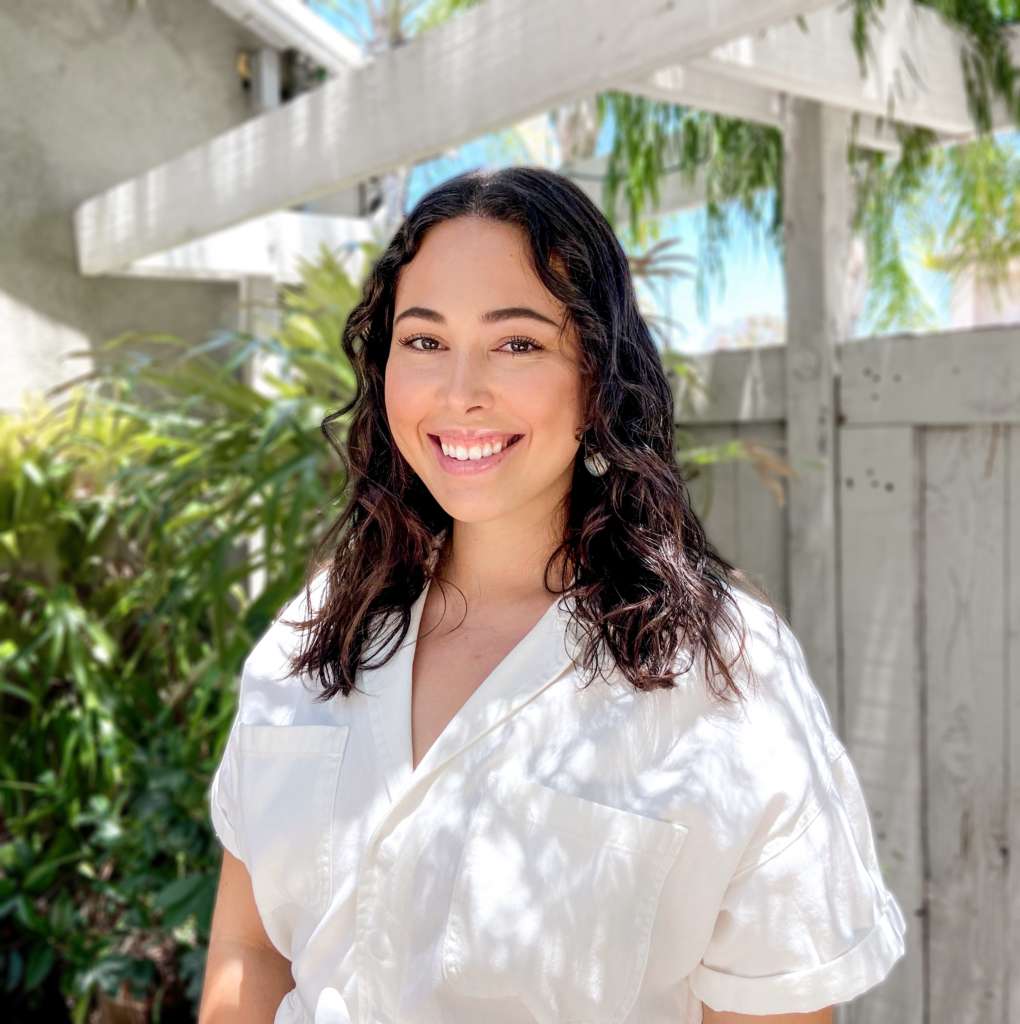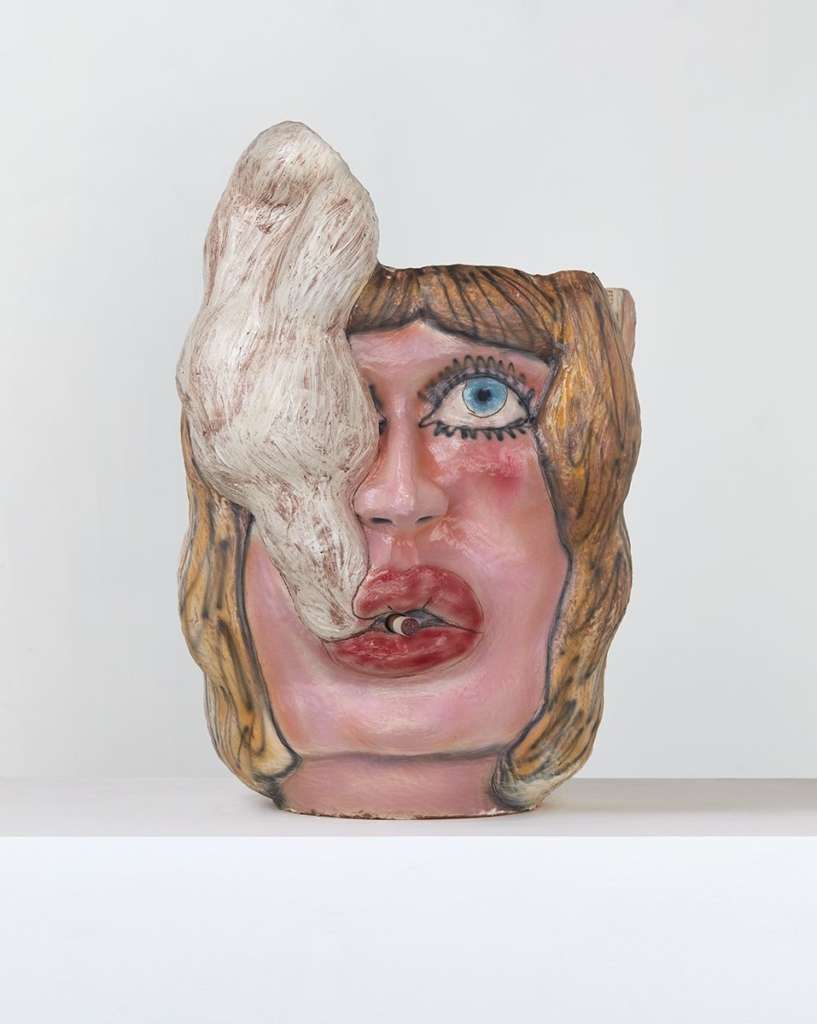Ruby Neri, Untitled (Dancing Women), 2018. Ceramic with glaze, 34.5 x 42 x 21 inches. (Jeff McLane / David Kordansky Gallery)

Hi! My name is Alyson, and I’m this year’s Getty Marrow Intern at AMOCA. I recently graduated from Chapman University with a BA in Art History and a minor in Anthropology.
As part of my internship, an ongoing project that I’ve been working on involves researching artists for a future exhibition on women working with ceramics in California. I’ve learned a lot about the history of ceramics in California during this process: the stylistic differences between Northern and Southern California, the pioneers who had to make their own glazes and clay bodies before they were commercially available, and the contemporary generation of women working in clay today.
One artist whose work I have found especially interesting is Ruby Neri and her colorful and oversized female vessels. Neri grew up in San Francisco as an active participant in the Mission School, a 90s counterculture art group, where she spray painted public surfaces before moving onto painting. Now, at 50, Neri works in L.A. creating oversized sculptures of the female form ranging from 400-800lbs, while still maintaining the graffiti aesthetic she started her career with by spray painting on underglaze.
At first glance, viewers may think of the nude sculptures as being depictions of hypersexualized women. Some dance; some smoke cigarettes; some pose nude wearing nothing but the outline of spray painted high heels. In an interview with the New York Times last year, Neri countered this argument, stating instead that her female forms are representational of the various facets of being a woman, including Neri’s own identities of being “a mother, lover, daughter, and maker.” The fact that Neri is creating these women in the form of a vessel is charged in itself; throughout history the vessel has been seen as a feminine and passive container, while also bearing the shape of the female form. Neri reconfigures her vessels to show a more holistic view of the female experience, with emphasis on femininity and gendered ties to nature (many of her works show nude women standing among flowers).
In a review of Neri’s 2019 show at the David Kordansky Gallery, Leah Ollman from the L.A. Times described Neri’s work as closing the gender gap in large ceramic sculpture by using a sense of machisma, in opposition to the male-gendered machismo. This description resonated with me as someone who is fairly new to researching ceramic’s history. In the 1950s and 60s, leading ceramic artists such as Viola Frey and Nancy Selvin were breaking away from the studio potter tradition started by the previous generation of California ceramicists. At the same time, Peter Voulkos and his peers were creating large brutalist works that critics tied to masculinity. Neri’s oversized works challenge the notion that large scale work is tied to masculinity, while also leading the current generation of women artists, many of whom are now using their work to discuss important themes of identity and politics.

Ruby Neri in her studio (Chantal Anderson) 
Ruby Neri, Smoking Woman, 2017. Ceramic with glaze, 35 x 31 x 26 inches. (Jeff McLane / David Kordansky Gallery) 
Ruby Neri, Women With Dolls in Their Laps, 2019. Ceramic with glaze, 51.5 x 54.5 x 30 inches. (Jeff McLane / David Kordansky Gallery) 
Ruby Neri, Women Playing With Dolls, by Ruby Neri, 2017. Ceramic with glaze, 43 1/2 x 40 1/2 x 27 1/2 inches. (Jeff McLane / David Kordansky Gallery)
Interested in learning more? Check out the following related readings:
“In the Studio With an Artist Who Makes Giant Woman-Shaped Vases,” Anna Furman (2019).
“Review: Ruby Neri sculpts flamboyant, fearless, nakedly female figures,” Leah Ollman (2019).
Alyson Brandes is a graduate of Chapman University and a 2020 Getty Marrow Undergraduate Intern at AMOCA. During her internship, Brandes writes periodically for AMOCA.org, and posts on Instagram and Facebook on Tuesdays. Read her blog posts:
- Asco and the Hierarchies of Art
- Feminizing Brutalism: Ruby Neri and Her Giant Vessels
- The Cinematic Roots of Clay
- The Colorful World of Miss Anna Valdez
- Split Vessels: Jenny Hata Blumenfield
- The Legend of Beatrice Wood
- Nicole Seisler: Rituals, Processes and Documentation
- Ashwini Bhat
- Nancy Selvin: The Abstraction of Art History
- New Acquisitions: Trompe l’Oeil
- Kim Tucker’s “Primal Beings, Ghosts, and Human Dummies”
- Blue Boys and Farmers: Howard Kottler’s Queer Plates
- At the Center of Nicki Green
- The Legacy of Sascha Brastoff
- End of Internship Reflection

